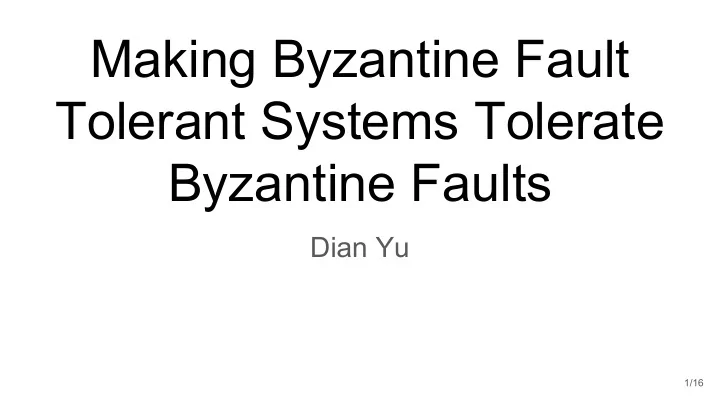

Making Byzantine Fault Tolerant Systems Tolerate Byzantine Faults Dian Yu 1/16
Comparison with PBFT (Traditional BFT protocols) Similarities: Build practical Byzantine fault tolerance systems Protocol: Clients → Primary → Replicas → Agreement Differences: (Robust) Signature for authentication Regular view change Point to point communication 2/16
Ideal BFT systems “Handle normal and worst case separately as a rule because the requirements for the two are quite different. The normal case must be fast. The worst case must make some progress ” Gracious execution: synchronous execution. All clients and servers behave correctly Uncivil execution: synchronous execution. Up to f servers and any numbers of clients are Byzantine 3/16
Problem with PBFT/Zyzzyva Misguided: current BFT systems can survive Byzantine faults, but completely unavailable by a simple failure Dangerous: encourages fragile optimizations Futile: Further improvements have little effect on performance 4/16
Aardvark: RBFT in action 3 stages: 1. Client request transmission 2. Replica agreement 3. Primary view change 5/16
Signed client requests - MAC 6/16
Digital Signature 7/16
Signed client requests - digital signatures Problem with MAC: no non-repudiation property of digital signatures Solution: Signature ● Valid MAC but not valid signature: ○ Not routine message corruption ○ Significant fault or malicious behavior with client Denial-of-service attack? 1. Hybrid MAC-signature construct 2. Complete one request first 8/16
Resource isolation Separate network interface controllers (NICs) Separate work queues for clients and replicas Hardware parallelism 9/16
Regular view changes System throughput remains high when replicas are faulty (uncivil intervals) Cost of a view change is similar to the regular cost of agreement 10/16
Protocol Description 11/16
Client request transmission Fundamental challenge: Each replica comes to the same conclusion about the authenticity of the request Request: Analysis: Signature check: ensures only requests that will be accepted by all correct replicas are processed. Result: for every k correct requests submitted by a client, each replica performs at most k+1 signature verifications. 12
Replica agreement Fundamental Challenge: Ensure each replica can quickly collect the quorums of PREPARE and COMMIT messages necessary to make progress. Potential solution: 1. Design a protocol so that incorrect messages from faulty replica will not gain quorum 2. If quorum of timely correct replicas exists, a faulty replica cannot impede progress. 13
Catchup messages Benefit: allows temporarily slow replicas to avoid becoming permanently non-responsive Downside: faulty replicas impose significant load on non-faulty counterparts 14/16
Primary view changes Faulty primary: delay processing requests, discard requests, corrupt clients’ MAC authenticators, introduce gaps in the sequence number space, unfairly delay or drop clients’ requests Past systems: conservative. Only change when the current primary does not allow the system make even minal progress Aardvark: initiate a view change when delay exceeds heartbeat timer expires. Fairness: PRE-PREPARES from the same client 15/16
Analysis (with proof) 1. Peak throughput during a gracious view 2. During uncivil executions, with a correct primary Aardvark’s throughput at least g times the throughput of a gracious view 16/16
Conclusion All previous BFT (PBFT, QU, HQ, Zyzzyva) were broken under Byzantine fault A system surviving the worst case doesn’t mean it works well. Should make it work well in worst case as well. A small adaptation for parallelism might improve the performance a lot A robust system should give adequate performance in any scenario 17
Questions? 18
Recommend
More recommend